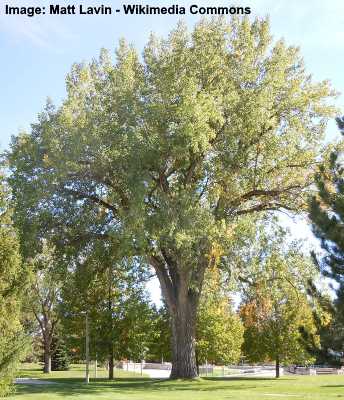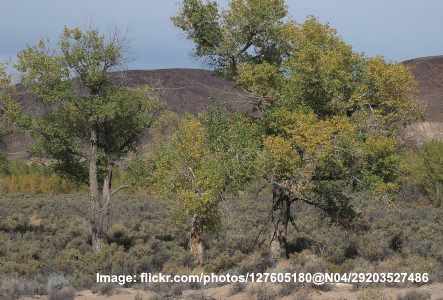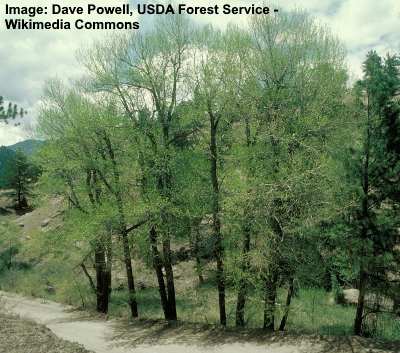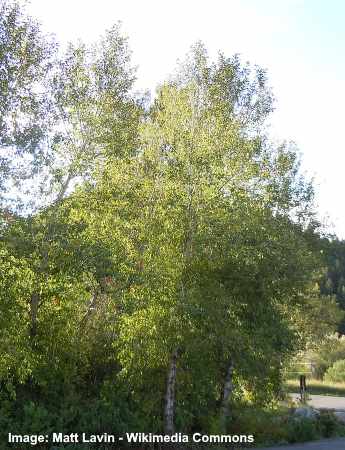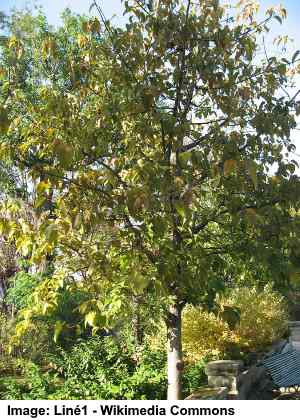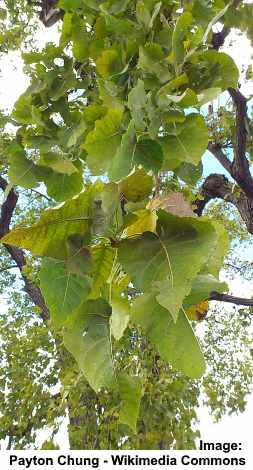Cottonwood Trees: Facts, Identification, Pictures, Problems, and More
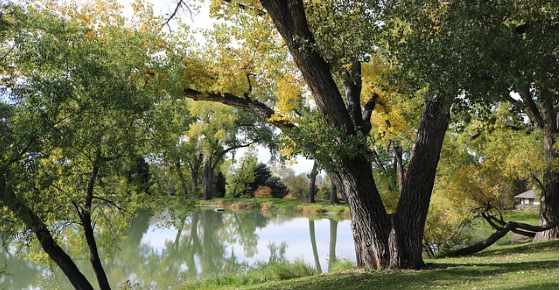
Cottonwood trees are huge deciduous trees that have large green leaves and thick foliage. One of the common features of all types of cottonwood trees is the fluffy cotton-like strands that appear every June. Cottonwood trees are common in North America, Europe, and some parts of Asia. Some reasons why cottonwood trees are popular are that they are fast-growing, their timber is cheap, and they thrive in wetlands and arid environments.
Cottonwood Tree (Populus deltoids)
Cottonwood trees are species of poplar trees belonging to the genus Populus. There are only a few species of poplar trees that are classified as cottonwoods. The 3 main species are Populus deltoids (eastern cottonwood), Populus fremontii (Fremont’s cottonwood), and the Populus nigra (black poplar).
Cottonwoods are large trees that can grow to between 50 and 80 ft. (15 – 24 m). Some species of cottonwood trees have been known to reach heights of 100 ft. (30 m) or more. Cottonwood trees are also large shade trees and their sprawling branches have a spread of up to 113 ft. (34 m). Being a species of a poplar tree, cottonwoods are also related to aspens.
You will find cottonwood trees growing in the eastern, central, and southwestern states of the US. Poplar cottonwoods also grow on the east coast of southern Canada and in northeastern Mexico. These hardwood trees are also found in deciduous forests.
According to the United States Department of Agriculture (USDA), cottonwoods grow in areas of full sun and in moist, well-drained sandy soil. (1)
Cottonwoods have an impressive growth rate and grow about 3 ft. (1 m) every year. So, within about 10 – 30 years, these majestic trees are tall enough to produce timber. Some types of cottonwood such as the narrowleaf and Fremont species can live for up to 150 years. The lanceleaf cottonwood, however, will only live for up to 50 years.
In this article, you will find out information about cottonwood trees. Along with pictures of cottonwood tree species, descriptions of the bark and leaves will help to identify these large native North American trees.
Cottonwood Leaves, Bark and Flowers – Identification Guide
Here’s how to identify cottonwood trees using their leaves, bark, and flowers.
Cottonwood Leaves
Cottonwood leaves are large, shaped like a triangle and have toothed edges. Cottonwood leaves grow alternately on branches and have a flat stem. The big glossy triangular leaves dangle down from the stems. Their flat wide edge and flat stem make them “clatter” in the wind. Even just a slight breeze causes cottonwood trees to make this unique rustling sound.
Cottonwood Bark
Mature cottonwood trees have a thick bark that is deeply fissured. This grayish-brown bark helps protect this native tree from drought and fire.
Cottonwood Flowers
Cottonwood flowers look like small fuzzy buds (catkins) with reddish or yellowish flowers. These flowers produce cottonwood fruits. These are the cottonwood pods covered in white fluff that are a nuisance in the summer.
Other Interesting Cottonwood Tree Facts
The fast growth rate of cottonwood trees and the strength of the timber means it has many uses. In fact, cottonwoods are one of the fastest-growing trees in North America. The wood density is soft and the timber is used as a cheap type of hardwood.
The name “cottonwood” comes from the fluffy white substance that surrounds the seeds. These develop on the tree in early summer and can create a blanket of summer “snow” when they disperse in the wind. Only the female species of cottonwood trees produce the white fluff for which the tree is known.
To Native Americans, the tree was extremely important. The gently spreading shape of the tree provided shade in grasslands. Even today, cottonwoods are grown in parks and other areas for the excellent shade from their dense foliage.
Cottonwood Tree Fluff
One of the unique aspects of cottonwood trees is the white soft fluff that seems to get everywhere. The trees are notorious for fluffy strings of seeds that get carried great distances in the breeze.
For many people, the fluff from cottonwood trees is a nuisance. Some people describe the tree as the most hated tree in America. The light white fluffy fibers can accumulate in yards, get into homes, block drains and gutters, and clog up filters. These poplar trees shed cotton during June and July.
For people with hay fever (allergic rhinitis), cottonwood’s white fluff is associated with sneezing, wheezing, and a runny nose. However, it is the pollen from the cottonwood tree that causes the majority of hay fever symptoms. Although, some studies do show that people can suffer from allergic reactions to the cotton. (2)
Types of Cottonwood Trees (with Pictures and Names) – Identification Guide
Let’s look at the different species of trees in the Populus genus that make up the cottonwood species.
Eastern Cottonwood (Populus Deltoides)
Also called the necklace poplar, the eastern cottonwood tree grows throughout the central and eastern regions of the United States. These are some of the largest and fastest-growing trees. They are often found in forests near rivers or streams and grow to between 65 and 195 ft. (20 – 60 m) high.
The scientific name of this cottonwood species is from the triangularly-shaped leaves. The “delta” leaves are between 1.5” to 4” long (4 – 10 cm) and about the size at their widest part. You will notice the leaves have a serrated edge and the curved triangle shape tapers to a sharp, elongated point.
There are some subspecies of this common poplar tree:
- Plains cottonwood specimens (d. monilifera) are found in Minnesota, Kansas, Nebraska, and Wyoming. In fact, the cottonwood tree is the state tree of Kansas.
- Rio Grande cottonwood trees (d. wislizeni) can be found growing in Texas, Colorado, Arizona, and northeastern Mexico.
In fall when the color of the cottonwood leaves changes, the dark green foliage turns a stunning yellow. Another way to tell this species of poplar apart from other broadleaf trees is the rustling sound the leaves make in a gentle breeze.
Cottonwood tree identification
Eastern cottonwood leaves are triangular (deltoid) with curved teeth along the edges. The bark is smooth and silvery-white when young and becomes hard, gray, and deeply fissured as the tree matures. Flowers on the eastern cottonwood species are reddish on male trees and yellowish-green on female trees.
Black Cottonwood (Populus Nigra)
More commonly found in Europe and Asia, the black cottonwood also grows on the western coast of the US. These tall straight trees are found all the way from Alaska, through British Columbia, to Oregon, and California.
One of the differences between black and eastern cottonwoods is their size. Black cottonwoods only grow to about 90 ft. (27 m) high which is shorter than their North American cousins. The leaves are also smaller and can be diamond or triangular-shaped and grow to between 2” – 3” (5 – 8 cm) long.
Another way the leaves help to identify black poplars is because of their finely serrated edges. Usually, most cottonwood species of tree leaves have pronounced tooth edging whereas black poplars are almost smooth-edged. Black cottonwood trees become stunning in the fall where their foliage turns a beautiful bright yellow color.
Similar to all species of cottonwood, black poplars are fast-growing trees that produce low-grade timber.
Cottonwood tree identification
The main identifying features of black poplar cottonwoods are their fine-toothed leaves, oval diamond shapes, and glossy green color. The bark is rough with deep furrows and is a gray-brown color. Both male and female black poplars produce yellow catkins.
Fremont’s Cottonwood (Populus Fremontii)
The third major cottonwood species is Fremont’s cottonwood. This huge majestic deciduous tree is also called the Alamo cottonwood as it is found in Texas and other southern US states. This cottonwood species is also classed as a riparian zone tree, meaning it thrives near rivers and streams.
Fremont’s cottonwoods grow to between 40 and 115 ft. (12 – 35 m) and they have a large spread that creates shade. The leaf shape of this cottonwood is more heart-shaped than triangular. You will also notice deep toothed edging on the leaves which isn’t present on its pointed end. If you compare them with eastern cottonwood leaves, you will see Fremont’s cottonwood leaves are smaller with less serration. As with all cottonwoods, the bark has deep fissures giving it a cracked appearance.
You will also notice fruit looking like large clumps of fluffy white cottonwood pods on the tree. These long white beads of fluff shed in June and July and are a nuisance for people living near them.
When the cottonwood leaves change color in the fall during October and November, they become bright yellow or orange.
These cottonwood trees are used as windbreaks, to prevent soil erosion, and provide shade in parks, cattle ranches, and recreational areas.
Cottonwood tree identification
Identification of Fremont’s cottonwood trees is by their cordate shaped leaves (heart-shape), coarsely serrated edges, and elongated smooth-edged tip. Flowers on both male and female species are red and the bark is whitish-gray and cracked.
Narrowleaf Cottonwood (Populus angustifolia)
Narrowleaf cottonwood trees are species of tree in the genus Populus and family Salicaceae (willow tree). As the name narrowleaf cottonwood suggests, these cottonwood trees have narrow leaves when compared to other cottonwood trees. The leaves are lanceolate and have scalloped edges.
These cottonwood trees grow in the western regions of North America at high altitudes. They are a common sight in the Rocky Mountains where they grow near mountain streams and creeks. Their tall stature and wide-spreading dense foliage mean they are great shade trees.
Narrowleaf cottonwood trees grow to about 98 ft. (30 m) tall and grow in zones 3 – 7. As with most species of trees in the cottonwood family, the timber is weak and the narrowleaf cottonwood tree is not commercially important.
Cottonwood tree identification
Elongated narrow leaves that are glossy green and turn sunny yellow in the fall.
Lanceleaf Cottonwood (Populus x acuminata)
Lanceleaf cottonwood is a type of cottonwood tree that is a hybrid between the eastern cottonwood and the narrowleaf cottonwood. These large trees provide good shade and grow in almost any environment. They are also fast-growing trees that are identified by their lance-shaped dark green glossy leaves, pyramidal shape, and hardiness.
Lanceleaf cottonwood trees grow to between 40 and 60 ft. (12 – 18 m) tall and have a spread of up to 40 ft. (12 m). These medium-sized trees are good for landscaping and shade. If you want to use a cottonwood tree in landscaping, then choose the ‘Highland’ cultivar as it doesn’t produce annoying cotton fluff in the summer.
Cottonwood tree identification
Leaf shape like a spearhead that turns from glossy green in the summer to bright yellow in the fall.
Chinese Necklace Cottonwood (Populus lasiocarpa)
The Chinese necklace cottonwood is a delightful shade tree with large leaves and dense foliage. The leaves of this cottonwood are some of the largest of any of the cottonwood trees. Leaves can grow up to 13” (35 cm) long and 10” (25 cm) wide.
This cottonwood species has long buds that grow up to 3 cm and these bloom into yellowish flowers. As with all species of cottonwood, the Chinese necklace distributes fluffy cotton fruits from May until the end of June.
Cottonwood tree identification
The Chinese necklace cottonwood can be identified by its massive green leaves in a triangle shape that create lush foliage. These dark shiny leaves turn to impressive bright yellows in the fall.
Swamp Cottonwood (Populus heterophylla)
Swamp cottonwoods are another species of massive tree that grows in temperate regions in North America. These fast-growing trees can reach heights of 50 ft. (15 m) in just 20 years. These trees are usually found growing along the Mississippi and in states such as in Tennessee, Illinois, Ohio, and Indiana.
Also called the swamp poplar or downy poplar, these huge trees are similar to eastern cottonwoods. Rather than having a delta-shaped leaf, swamp cottonwood trees have heart-shaped leaves. You can tell the male and female species apart because the males have yellow catkins and the females have green colored ones.
Cottonwood tree identification
Swamp cottonwoods can be identified by their Cordate (heart-shaped) large oval leaves that are up to 6” (15 cm) long and with an elongated tip. The leaf edges are slightly serrated.
Cottonwood Tree Problems
Cottonwood trees are not the ideal type of landscaping tree for small or medium-sized backyards. Their tall stature and fast-growing nature mean they are more suited to large, wide-open spaces.
Of course, the cotton fluff they shed in early summer is a problem for most people living near to cottonwood trees.
One of the other problems with these types of poplar trees is that they are susceptible to diseases and bugs. Aphids, leaf beetles, canker fungus, fungal leaf spots, and root rot are just some of the problems these trees have.
Cottonwood Tree Uses
Under the right conditions, cottonwood trees are some of the best shade-providing trees in large areas. City planners also use cottonwood trees for urban areas because of their hardiness, low maintenance, and ornamental look. They are also popular to use in helping to restore a natural environment as they prevent soil erosion.
The trees are also used in large parks to attract different kinds of wildlife and create windbreaks.
Due to the fact that cottonwood lumber is soft, yet durable, it has many uses in the timber industry. Cottonwood trees provide cheap timber for making pellets, boxes, crates, and also pulp for paper.
Related articles:





